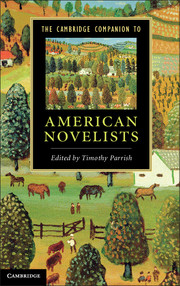Book contents
- Frontmatter
- Contents
- Contributors
- Introduction
- 1 James Fenimore Cooper
- 2 Nathaniel Hawthorne
- 3 Herman Melville
- 4 Harriet Beecher Stowe
- 5 Mark Twain
- 6 Henry James
- 7 Edith Wharton
- 8 Theodore Dreiser
- 9 Willa Cather
- 10 F. Scott Fitzgerald
- 11 Ernest Hemingway
- 12 William Faulkner
- 13 Henry Roth
- 14 Djuna Barnes
- 15 Zora Neale Hurston
- 16 Richard Wright
- 17 Raymond Chandler
- 18 Ralph Ellison
- 19 J. D. Salinger
- 20 Patricia Highsmith
- 21 Vladimir Nabokov
- 22 Jack Kerouac
- 23 Saul Bellow
- 24 Kurt Vonnegut
- 25 John Updike
- 26 Thomas Pynchon
- 27 Toni Morrison
- 28 Philip Roth
- 29 Don DeLillo
- 30 Cormac McCarthy
- Guide to Further Reading
- Index
- References
10 - F. Scott Fitzgerald
Published online by Cambridge University Press: 05 December 2012
- Frontmatter
- Contents
- Contributors
- Introduction
- 1 James Fenimore Cooper
- 2 Nathaniel Hawthorne
- 3 Herman Melville
- 4 Harriet Beecher Stowe
- 5 Mark Twain
- 6 Henry James
- 7 Edith Wharton
- 8 Theodore Dreiser
- 9 Willa Cather
- 10 F. Scott Fitzgerald
- 11 Ernest Hemingway
- 12 William Faulkner
- 13 Henry Roth
- 14 Djuna Barnes
- 15 Zora Neale Hurston
- 16 Richard Wright
- 17 Raymond Chandler
- 18 Ralph Ellison
- 19 J. D. Salinger
- 20 Patricia Highsmith
- 21 Vladimir Nabokov
- 22 Jack Kerouac
- 23 Saul Bellow
- 24 Kurt Vonnegut
- 25 John Updike
- 26 Thomas Pynchon
- 27 Toni Morrison
- 28 Philip Roth
- 29 Don DeLillo
- 30 Cormac McCarthy
- Guide to Further Reading
- Index
- References
Summary
All he was was one of our best novelists, one of our best novella-ists, and one of our finest writers of short stories.
John O’HaraIn a new biography of J. D. Salinger, we learn that F. Scott Fitzgerald was one of the most important influences on the writer of the novel that was to become one of the most popular of the twentieth century – and beyond, The Catcher in the Rye (1951). Salinger had met Hemingway in 1945, shortly after the American troops of World War II entered Paris. He knew from Hemingway’s writings that he could be found at the Ritz Hotel, so Salinger wrote to “Poppa” and asked whether he could meet him at the Ritz Bar. He knew of the conflict between Fitzgerald and Hemingway and was careful not to reveal his admiration for the writer who, for him, far exceeded the merits not only of Hemingway, but of William Faulkner and Sherwood Anderson as well. Indeed, for Salinger, Fitzgerald belonged with Hawthorne, Melville, Mark Twain, Henry James, and the other masters of fiction from the previous century.
The importance of The Great Gatsby rests partly on its entrance into our vocabulary – as a word with specific connotations: “gatsbyesque” today is short for the desire to raise oneself out of a lower-class background, to achieve in life the dreams that the early settlers of the country pursued until they were able to rise on the social ladder, realizing the possibilities they had always believed awaited them. Although this classic sells more than 300,000 copies every year, it did not achieve the instant success that might have been expected. Fitzgerald’s first novel, This Side of Paradise (1920), was the work that catapulted him into instant fame. Although it was rejected in its original form, titled The Romantic Egotist, the editor Maxwell Perkins, with whom Fitzgerald had been corresponding, urged him to revise it and to resubmit it to Scribner’s.
- Type
- Chapter
- Information
- The Cambridge Companion to American Novelists , pp. 92 - 103Publisher: Cambridge University PressPrint publication year: 2012
References
- 14
- Cited by

